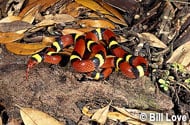Scarlet Kingsnake
Southeastern U.S. from Virginia to Florida, west to southern Kentucky and eastern Louisiana.
The scarlet kingsnake is considered a full species, Lampropeltis elapsoides, by many herpetologists.
Considered one of the most challenging kingsnakes to keep because of its small size and the difficulty of finding proper food, scarlet kingsnakes are also notorious escape artists. Provide a 10-gallon terrarium with a locking, very secure lid and a substrate of anything from aspen to indoor-outdoor carpeting. Some keepers suggest that a 20-gallon vertical terrarium with the lid at the top may be necessary to prevent escapes. The terrarium must stay fairly moist, so give water in a wide, shallow bowl. These are nervous snakes that do not like bright lights and need several hiding places in the terrarium. Room temperatures between 75 and 85 degrees Fahrenheit are adequate, with a small drop at night. An undertank heating pad is not necessary, and basking lights may be harmful.
Scarlet kingsnakes are specialist feeders on elongated lizards, especially young anoles and skinks. Many specimens will accept only living lizards as food and will starve rather than switch to pinky or hopper mice or even frozen, thawed lizards. Add food to the terrarium before the lights are turned off for the night. Some specimens can be tricked into accepting mice rubbed with lizard droppings or placed inside the body cavity of a dead lizard to transfer scent. Newly hatched young should be considered only by advanced keepers. This beautiful little snake is seldom bred in captivity.

